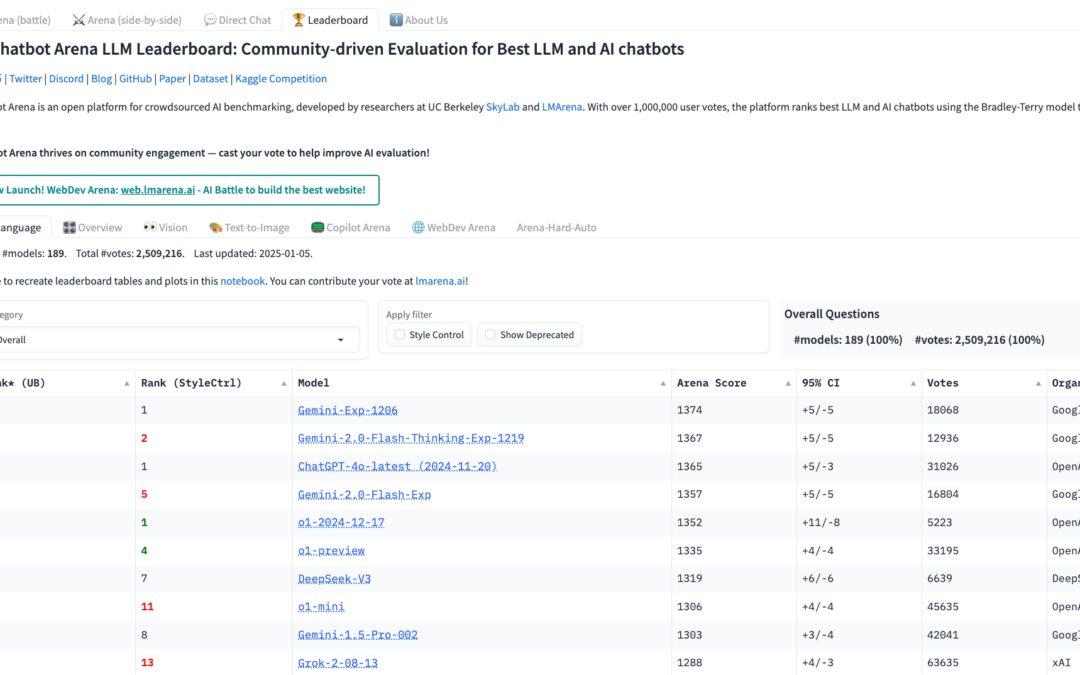6 Trends and the latest practical innovations which will change marketing in the year(s) ahead
We all now know that Generative AI (Gen AI) has already made a huge impact on marketing and the wider world. Yet it will grow dramatically more in the future since, as we will see, many businesses have been surprisingly slow in adapting and adopting it. Plus there are some amazing innovations as we move towards AGI – Artificial General Intelligence where AI will possess the ability to understand, learn, and complete tasks at a level comparable to or exceeding that of a human being.
In this post, I’ll cover trends covering both AI strategy and how the GenAI tools are developing. You can learn more in our upcoming free webinar on AI trends in Marketing.
Those of use who have enthusiastically adopted AI in our marketing have become used to the incredible ability of GenAI to create compelling copy, visuals and code when provided with sufficiently detailed prompts. However, we’re also aware of its limitations and that’s what makes the next months and years particularly interesting. It’s already ‘incredible’, i.e. almost unbelievable what it can achieve, yet we are still the early stages, when you think of the limitations of GenAI. To choose just three limitations which I think restrict its use in marketing:
- Individual prompts. It mostly works on individual, specific prompts rather than working through a series of tasks and then taking decisions on the basis of each stage.
- Not truly conversational. It requires you to prompt it, rather than leading the conversation. The outputs are dependent on your skills at prompting, hence all the exhortations to develop prompt engineering skills. To me, a more natural model is where the AI can lead the conversation as exemplified by the AI-led approach of Pi from Inflection rather than the human-prompt led approach seen in ChatGPT, Gemini and Claude. However, these are all moving a more multimodal, conversational direction, which is one of our trends explained below.
- Poor integration with structured data. Yes, it’s good at parsing and creating static content in documents, but third-party tools are mostly required to integrate spreadsheets or databases. Tools introduced recently are already changing this, but there is room for large improvements here.
I’ll now review the main trends that will affect marketing as I see them as we enter 2025, prompted in part by the announcement of Gemini 2.0 by Google at the end of last year which showcased some jaw-dropping improvements we’ll see below.
I think it’s generally understood that despite Google investing in AI research and development of Large Language Models (LLMs) for well over a decade it was superseded by OpenAI when it launched ChatGPT and after its code red announcement it has been working hard to fight back and now may be clawing it’s way back into the lead.
This is illustrated by the latest AI Chatbot Arena benchmark – which is an open platform for crowdsourced AI benchmarking, developed by researchers at UC Berkeley and LMArena. With over 1,000,000 user votes, the platform ranks the best LLM and AI chatbots.
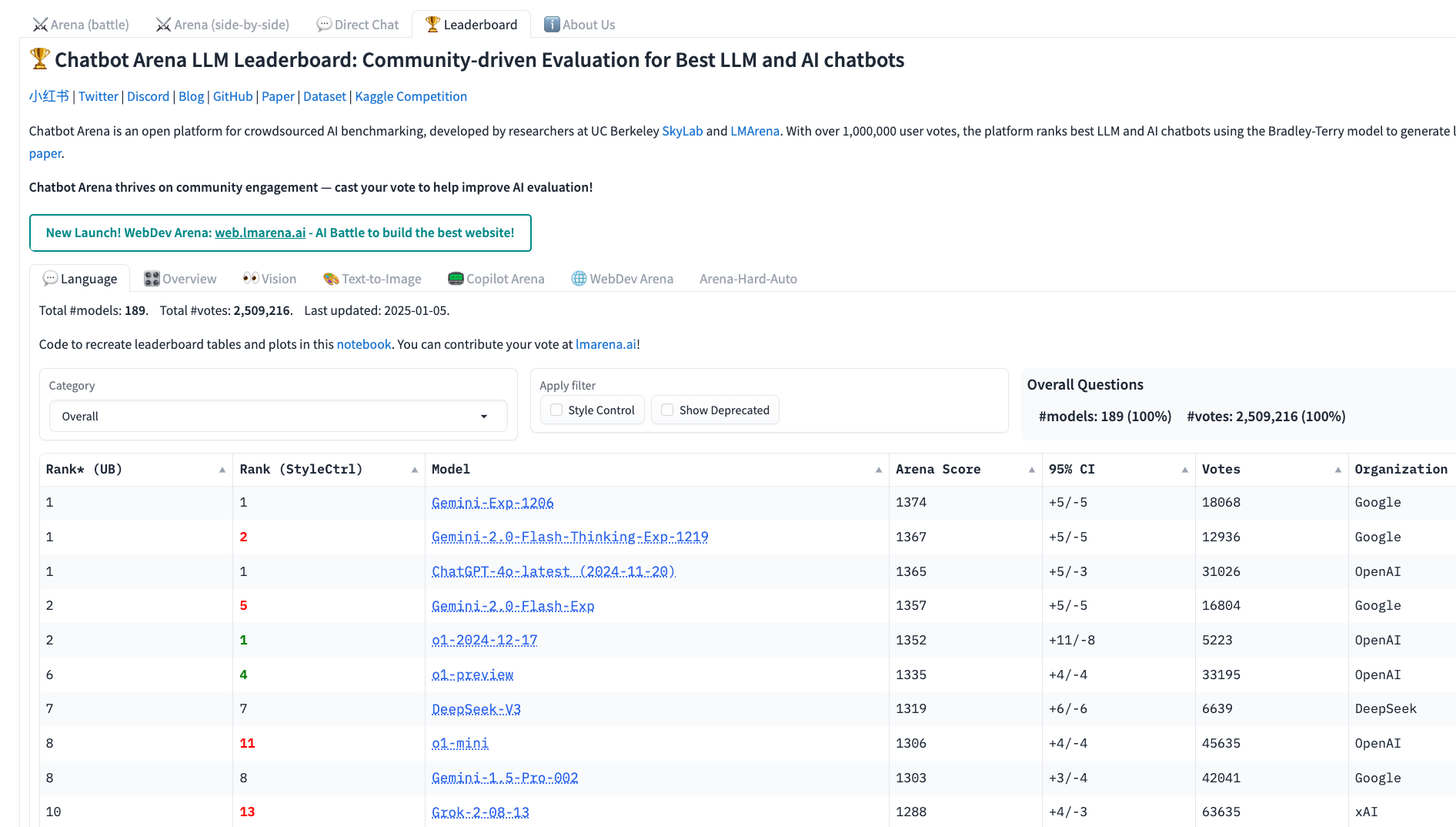
You can see that the leading models are now from Google according to this ranking and that, from a practical point-of-view, many AI influencers are raving about the power of Google’s AI Studio coupled with Gemini. This enables conversational dialogue with the AI and discussion to improve results from what’s shared on screen such as a web page, email or spreadsheet.
Here’s one marketing-led example which shows the value of this combination, particularly if you are in a marketing team of one who needs advice from and to bounce ideas off the AI – in this case about improving a landing page.
Other videos, such as those in our new premium member module on using AI Studio show how to use these for spreadsheet analysis and learning.
So, that’s a practical illustration of the recent innovation, let’s now take a look at my 6 key trends to watch for in the year(s) ahead. I start with more strategic organizational-level trends related to adoption and then move into more practical trends related to AI development
Trend 1. AI adoption in Marketing
From all the coverage around the impact of AI in marketing, you would think that every marketer is enthusiastically using GenAI day-to-day, but surveys suggest this isn’t the case.
In our Future of Digital Marketing report we produced in partnership again with Technology for Marketing and eCommerce Expo mid last year, we found that around one third of marketers weren’t using GenAI for common marketing applications. The most common applications of AI were, nevertheless, using it to support copywriting for email marketing, organic search and social media.
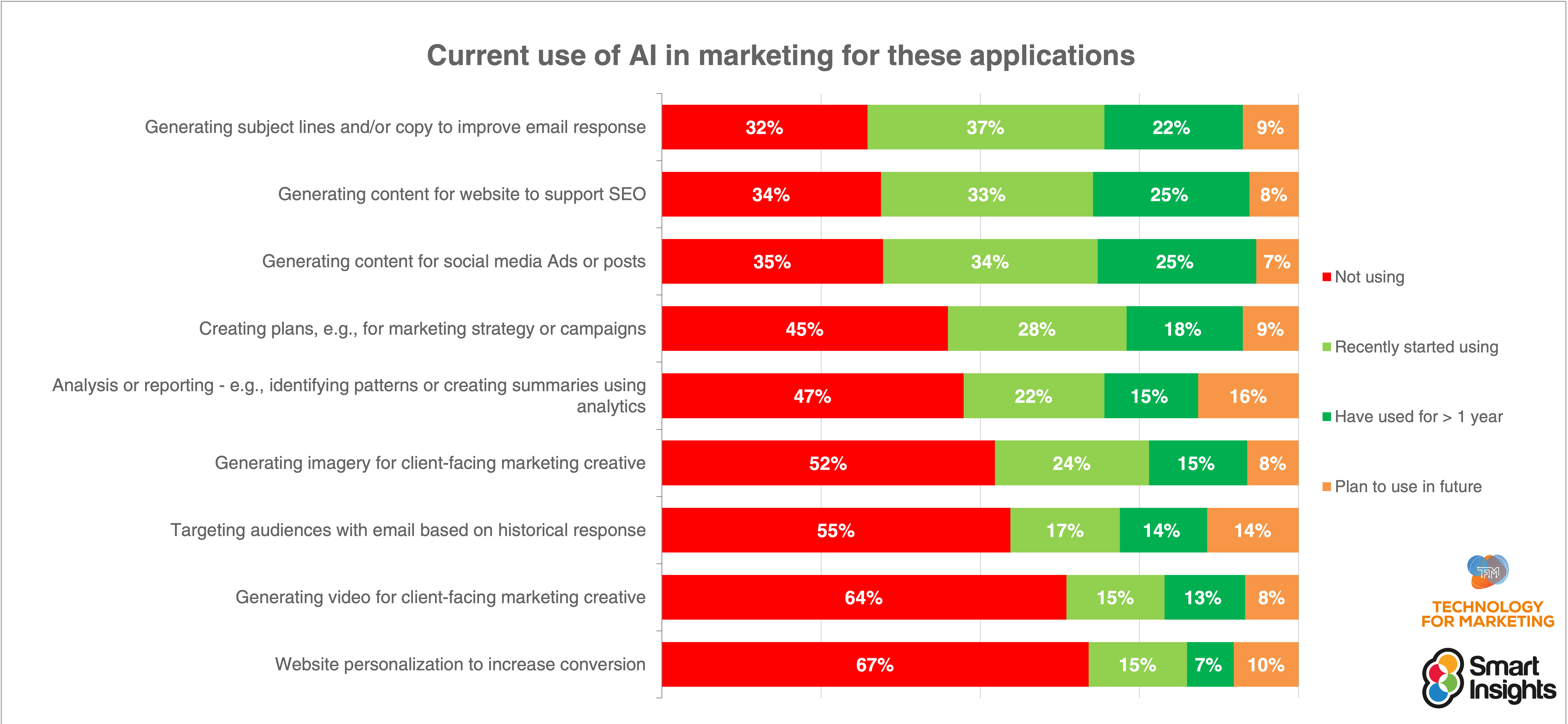
This is supported by the more recent Econsultancy Future of Marketing 2025 report where less than half of respondents were using it in their regular work.
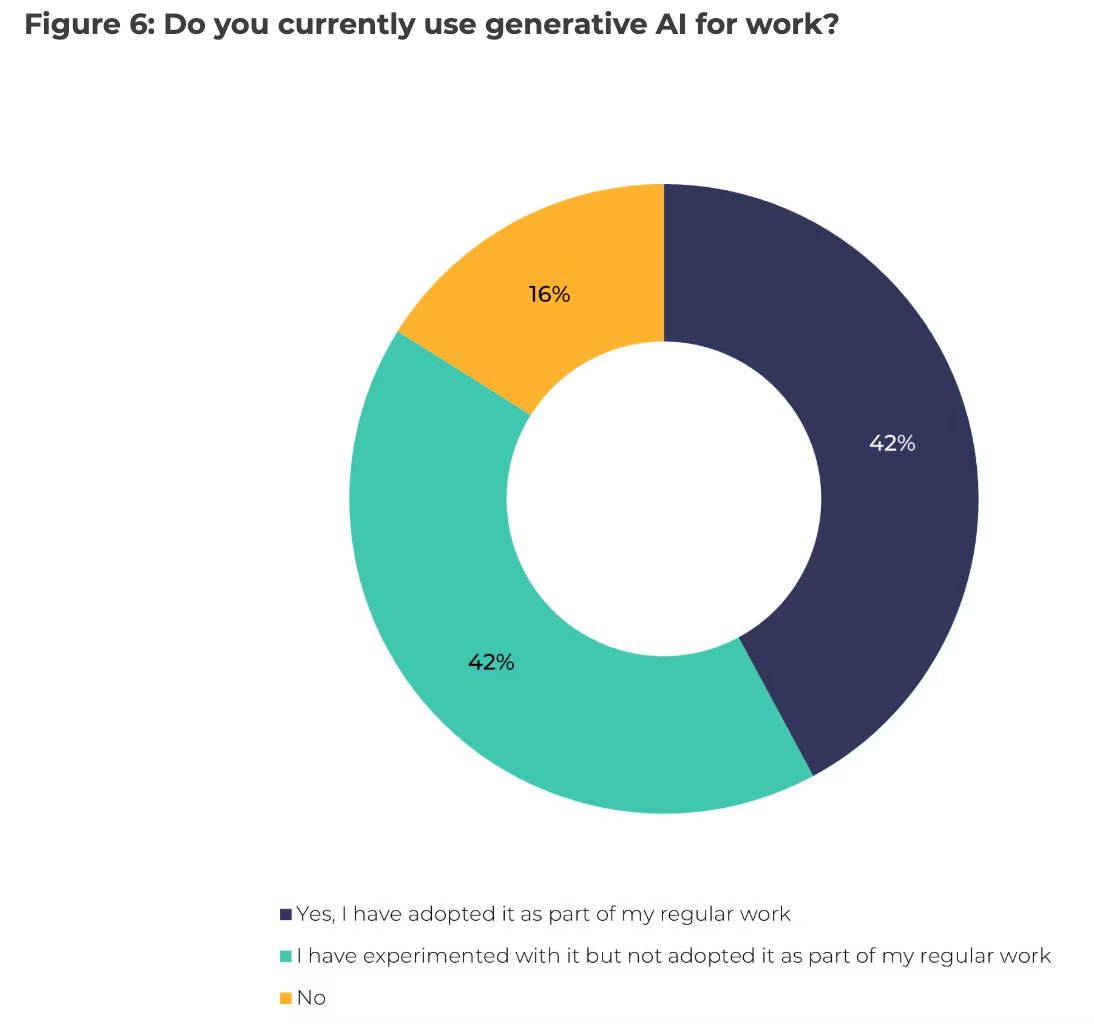
Trend 2. Managing AI strategically for Marketing
While individuals may be actively using GenAI tools this is quite different from using it coherently across a business. A more strategic use of AI involves:
- A strategy to prioritize adoption of AI use for different roles and use cases
- A playbook or governance plan to focus on specific use cases and tools and exclude others
- Investment in the latest paid for LLMs with the highest quality outputs
- Agreement on how to customize each AI to standardize brand tone-of-voice and audience appropriate style
- Using a prompt library to save time and get consistent results for common use cases
- A structured plan or programme to develop skills
Our research suggests that many businesses aren’t using AI in a strategic way since they don’t have a playbook to follow or training in place.
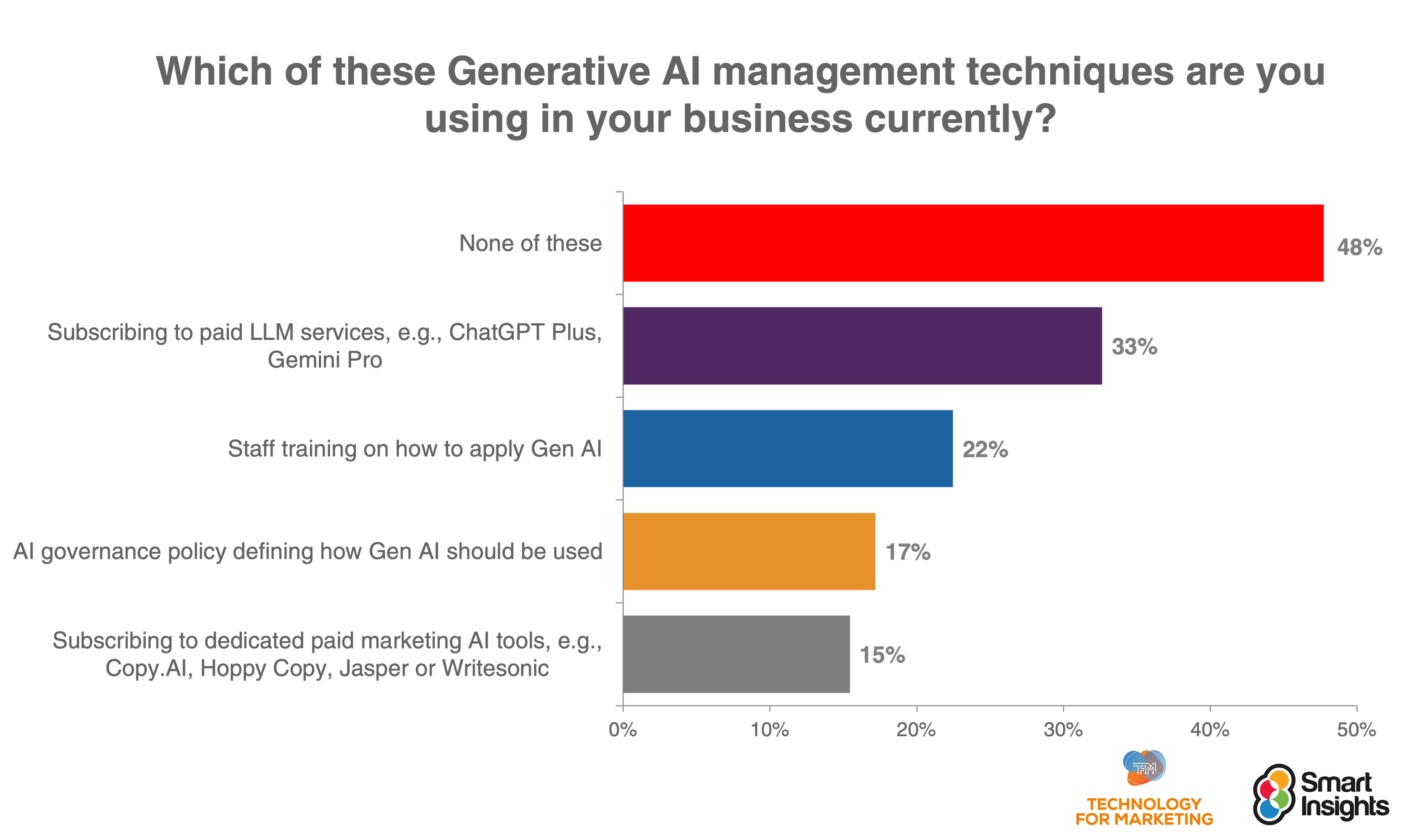
A Smart Insights, we believe controls are essential to maintain quality as we show in our AI for marketing governance policy template and article which wasn’t written by AI (apart from collaborating on the structure, an example of Smarter Marketing).
To support a structured plan or programme to develop skills we have built many learning courses for our premium members explaining how to create an AI strategy and with ‘hands-on’ modules on how to use ChatGPT and Gemini in marketing.

AI for Marketing Learning Path
Part of the Sector technology innovation Toolkit
Learn how to develop an AI marketing strategy and practical tips on using ChatGPT.
Core Module

Customizing ChatGPT for your marketing workflows with GPTs
Part of the Sector technology innovation Toolkit
This module is aimed at making you a smarter marketer who understands more advanced AI customization approaches such as creating GPTs.
Trend 3. Multimodality
This term was highlighted to me since its front and centre in Google’s new AI Studio: https://aistudio.google.com/live and their December announcement. It’s a trend we have seen with the evolution of ChatGPT that now supports multiple inputs and outputs.
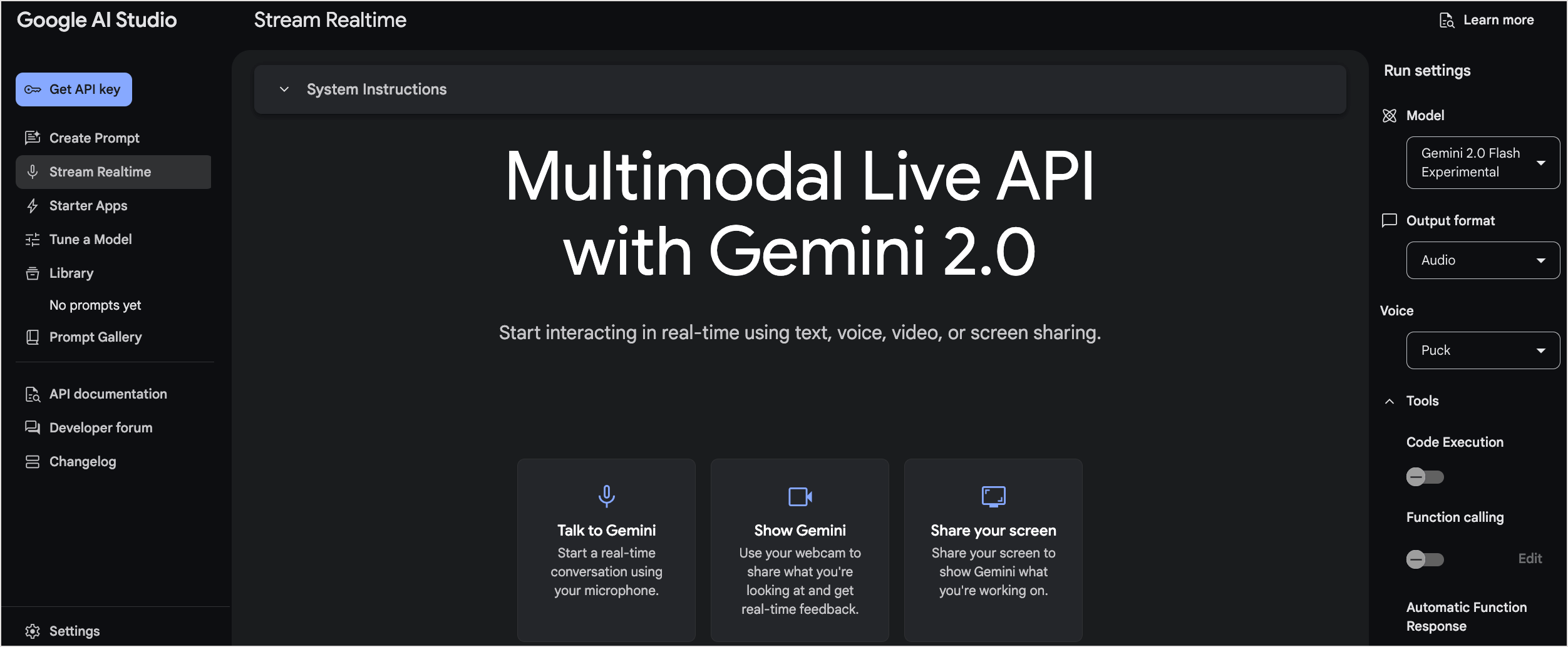
Key Aspects of Multimodality in AI are:
1. Multiple Input Types
The AI can process diverse inputs, such as:
• Text: Written or spoken language.
• Images: Photos, drawings, or visual data – possible in Gemini 2.0 via a web cam and screen sharing
• Audio: Speech, music, or sound effects
• Video: Moving images and context over time – also possible in Gemini 2.0
2. Cross-Modality Understanding
The AI can link information between modalities. For example:
• Generating a caption for an image (linking text to an image).
• Answering a question about a video (text linked to video).
• Transcribing audio into text while identifying the speaker’s emotions.
3. Contextual Integration
Multimodal AI integrates contextual information from different modalities to provide richer insights.
An example is where a virtual assistant uses speech (audio), the meaning of words (text), and visual cues (images or gestures from a camera) to interact naturally with a user. This is what Gemini is achieving through its examples.
4. Generative Capabilities
These include:
• Advanced multimodal AI systems can generate content across modalities:
• Text-to-image generation (e.g., DALL-E from OpenAI, not available in Gemini 2.0).
• Video summaries from text descriptions.
• Audio generation from written scripts.
Trend 3. Canvasses and Collaboration
This is perhaps a minor trend compared to the others, but it represents a big change in how we interact with the AI.
Traditionally, in tools like Photoshop or Canva, the “canvas” is where a user places elements (text, images, etc.) to create a design.
Within GenAI a canvas refers to the virtual workspace or blank digital surface where AI-generated images, designs, or artwork are created and the user can potentially interact with the Canvas.
I first noticed this trend with the release of Claude’s Artifacts in August 2024 which has been described as a ‘magic window’. It generates standalone pieces of content — be it code, documents, or interactive elements — that you can view and manipulate alongside your conversation with Claude.
This was followed up in October by OpenAI introducing Canvas, a new interface for working with ChatGPT on writing and coding projects that go beyond simple chat. Canvas opens in a separate window, allowing you and ChatGPT to collaborate on a project.
Trend 4. AI Shovelware
We’ve looked at many of the positive trends, here now is a negative trend.
AI Shovelware is now often used to refer to poor quality software and video games created by AI, but a trend I’m seeing, and am sure you’re seeing too, is long-form AI generated content from existing content. Here is just one useful example – the Trust Insights 2025 marketing trends report. It’s 90+ pages long, which given how busy we all are, and the ability of AI to summarize, isn’t the smartest move… Actually, it’s an interesting approach and more useful than many research reports since it uses AI to parse the last 90 days of posts and comments – from specific marketing Subreddit topics such as Digital Marketing, r/SEO and r/social media, each amounting to 300,000 to 500,000 words. At Smart Insights, we’ve reviewed Reddit the past few years as a way to understand the latest concerns of our audience, there are plusses as well and minuses of this content.
This article isn’t generated by AI since I still enjoy writing and experimentation has shown me that I think I can write more interesting, engaging, useful and unique content than even the latest LLMs trained on my content. However, I do use GenAI to summarize, working with it collaboratively to add hopefully value through my analysis and recommendations.
Trend 5. The Agentic era
This term was emphasized by Google with their Gemini 2.0 launch when Google Sundar Pichai described them as ‘models that can understand more about the world around you, think multiple steps ahead and take action on your behalf, with your supervision’.
An initial phase of this era is prompt chaining where AI workflows are implemented by combining multiple prompts into a sequence. The output of one prompt serves as the input for the next, allowing the AI to perform complex, multi-step tasks. This approach is needed for breaking down large or intricate problems into smaller, manageable steps while ensuring better control over the AI’s reasoning process.
Google’s Project Mariner is a research prototype built with Gemini 2.0 that explores the future of human-agent interaction. As a research prototype, it’s able to understand and reason across information in your browser screen, including pixels and web elements like text, code, images and forms, and then uses that information via an experimental Chrome extension to complete tasks for you. Here is a demo that illustrates prompt chaining:
This demo is the closest I have seen to what PR Smith, my co-author on Digital Marketing Excellence described back in 2001 as intelligent agents which would shop for you!
ChatGPT is limited in this regard although wrappers can be created with the API to attempt prompt chaining. As a ‘baby step’ towards this, in 2025, OpenAI added scheduled tasks in Beta which gives ChatGPT the ability to create tasks for itself to run later. Tasks can be triggered either at specific times (one-off or recurring) or in the UI.
Trend 6. Quantum Computers
So, this certainly won’t affect you in 2025, practical applications are likely decades off, but there have been significant advancements which have moved it forwards the theory of the past decades where it has been heralded as the future.
This is back to the Google pre-Christmas example where according to Techcrunch, Google says its new Willow quantum chip indicates that multiple universes exist and it offers a benchmark where the speed of computation is mind-boggling:
“Willow’s performance on this benchmark is astonishing: It performed a computation in under five minutes that would take one of today’s fastest supercomputers 10 to the power 25 or 10 septillion years. If you want to write it out, it’s 10,000,000,000,000,000,000,000,000 years”.
I’m not going to attempt to explain the application of that, it would be nice if it helped us solve the division and hatred of the post-truth world we now live in…
So, these are the trends I see, what about you – do let me know on my LinkedIn – I’m enjoying learning from others.
I hope you enjoy the ride and challenge in the year(s) ahead.

